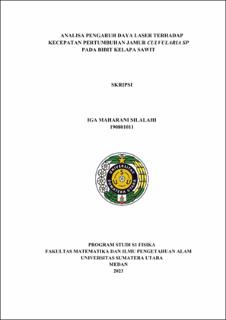Analisa Pengaruh Daya Laser terhadap Kecepatan Pertumbuhan Jamur Culvularia Sp pada Bibit Kelapa Sawit
Analysis of The Effect of Laser Power on The Growth Speed of Culvularia Sp Fungus in Palm Seeds

Date
2023Author
Silalahi, Iga Maharani
Advisor(s)
Situmorang, Marhaposan
Widiyatmoko, Bambang
Metadata
Show full item recordAbstract
This research aims to find other alternative ways to kill the culvularia sp fungus
or leaf spot disease that attacks oil palm seedlings. Using a blue laser with a
wavelength of 405 nm, a blue laser with a wavelength of 450 nm, and an infrared laser
with a wavelength of 810 nm which have been assembled so that the voltage can be
adjusted as an irradiator. The first thing that must be done is to test the stability of the
laser with increasing distance (cm) and increasing time per 30 minutes for 5 hours. In
research on controlling fungal growth, the voltage on each laser was set at 4 volts,
4.25 volts, 4.50 volts. Then, the lasers are connected to optical fibers so that the light
obtained from the laser is transmitted from one place to another. The optical fiber is
directed several cm directly above the purified fungal sample. The analysis was
carried out by irradiating the sapel fungus using a laser that had been assembled with
different laser powers to see the results of the laser and what power range could reduce
the development of the culvularia fungus. The laser power that is effective in slowing
down fungal growth is: 405 nm wavelength blue laser with an input power of 33 mW,
450 nm wavelength blue laser with an input power of 15 mW and 810 nm wavelength
infrared laser with an input power of 810 nm. To see the wavelengths that are effective
in slowing down fungal growth, fungal irradiation is carried out using a blue laser
(high energy photons) and an infrared laser (low energy photons) with the same power
input. Infiltrated laser irradiation with a power of 66 mW appears to be more effective
in reducing the development of the fungus culvularia sp.
Collections
- Undergraduate Theses [1307]
